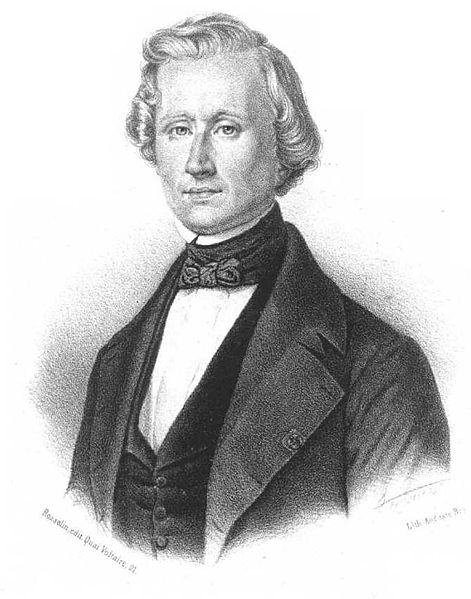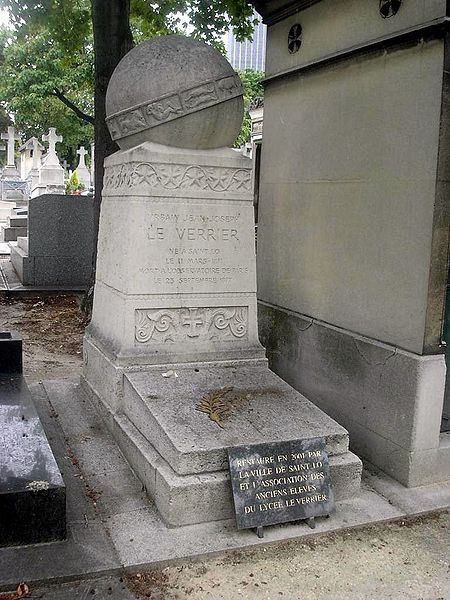<Back to Index>
- Astronomer Urbain Jean Joseph Le Verrier, 1811
- Poet Torquato Tasso, 1544
- Prime Minister of the United Kingdom James Harold Wilson, 1916
PAGE SPONSOR


Urbain Jean Joseph Le Verrier (11 March 1811 – 23 September 1877) was a French mathematician who specialized in celestial mechanics and is best known for his part in the discovery of Neptune.
Le Verrier was born in Saint-Lô, France, and studied at the Ecole Polytechnique. Following a brief period studying chemistry under Gay-Lussac, Le Verrier switched to astronomy, particularly celestial mechanics. He accepted a job at the Paris Observatory, where he spent most of his professional life, and eventually became that institution's Director. In 1855, he was elected a foreign member of the Royal Swedish Academy of Sciences.
Le Verrier's most famous achievement is his prediction of the existence of the then unknown planet Neptune, using only mathematics and astronomical observations of the known planet Uranus. Encouraged by physicist Arago, Director of the Paris Observatory, Le Verrier was intensely engaged for months in complex calculations to explain small but systematic discrepancies between Uranus's observed orbit and the one predicted from the laws of gravity of Newton. At the same time, but unknown to Le Verrier, similar calculations were made by John Couch Adams in England. Le Verrier announced his final predicted position for Uranus's unseen perturbing planet publicly to the French Academy on 31 August 1846, two days before Adams's final solution, which turned out to be 12° off the mark, was privately mailed to the Royal Greenwich Observatory. Le Verrier transmitted his own prediction by 18 September letter to Johann Galle of the Berlin Observatory. The letter arrived five days later, and the planet was found with the Berlin Fraunhofer refractor that same evening, 23 September 1846, by Galle and Heinrich d'Arrest within 1° of the predicted location near the boundary between Capricorn and Aquarius.
There was, and to an extent still is, controversy over the apportionment of credit for the discovery. There is no ambiguity to the discovery claims of Le Verrier, Galle, and d'Arrest. Adams's work was begun earlier than Le Verrier's but was finished later and was unrelated to the actual discovery. Not even the briefest account of Adams's predicted orbital elements was published until more than a month after Berlin's visual confirmation. But Adams himself made full public acknowledgement of Le Verrier's priority and credit (not forgetting to mention the role of Galle) when he gave his paper to the Royal Astronomical Society in November 1846:
I mention these dates merely to show that my results were arrived at independently, and previously to the publication of those of M. Le Verrier, and not with the intention of interfering with his just claims to the honours of the discovery; for there is no doubt that his researches were first published to the world, and led to the actual discovery of the planet by Dr. Galle, so that the facts stated above cannot detract, in the slightest degree, from the credit due to M. Le Verrier.
In 1859, Le Verrier was the first to report that the slow precession of Mercury’s orbit around the Sun could not be completely explained by Newtonian mechanics and perturbations by the known planets. He suggested, among possible explanations, that another planet (or perhaps, instead, a series of smaller 'corpuscules') might exist in an orbit even closer to the Sun than that of Mercury, to account for this perturbation. (Other explanations considered included a slight oblateness of the Sun.) The success of the search for Neptune based on its perturbations of the orbit of Uranus led astronomers to place some faith in this possible explanation, and the hypothetical planet was even named Vulcan. However, no such planet was ever found, and the anomalous precession was eventually explained by general relativity theory.
Le Verrier had a wife and children. He died in Paris, France and was buried in the Cimetière Montparnasse. A large stone celestial globe sits over his grave. He will be remembered by the phrase attributed to Arago: "the man who discovered a planet with the point of his pen."